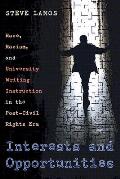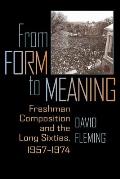Interests and Opportunities: Race, Racism, and University Writing Instruction in the Post–Civil Rights Era. Steve Lamos. Pittsburgh: University of Pittsburgh Press, 2011.
From Form to Meaning: Freshman Composition and the Long Sixties, 1957–1974. David Fleming. Pittsburgh: University of Pittsburgh Press, 2011.
Steve Lamos’s and David Fleming’s new books work to locate college composition during the turbulent years of the 1960s, when open admissions, racial protest, and the antiwar movement produced the boom years in the field of composition as institutions across the country scrambled to create new courses for a new student body. Lamos and Fleming both argue that we can learn critical lessons about contemporary writing instruction by revisiting the long sixties. The lessons they take, however, are quite different.
In Interests and Opportunities, Lamos seeks to trace how basic writing instruction for “highrisk” (underprepared low-income or minority) students has been shaped by white privilege and political ideology since the 1960s. Using the University of Illinois at Urbana-Champaign as his case study, he focuses particularly on how administrative and programmatic decisions affected the racial consciousness of UIUC’s educational opportunity program (EOP) rhetoric program. EOP rhetoric was instituted in 1968 as part of a larger initiative to recruit and retain five hundred African American students a year. For Lamos, 1968 was the apex of race-conscious writing instruction at UIUC. The rest of the book is intended to explain how the EOP rhetoric program was eventually dismantled, resulting in a shift toward a “color-blind” approach to writing instruction. In Lamos’s estimation, faculty members at UIUC (and, by extension, composition teachers generally) can either teach students race-conscious, identity-based writing or teach students to write Standard English. The UIUC faculty picked Standard English, and Lamos contends that it was a disastrous choice.
Lamos argues that this choice was driven by uncritical and unreflective appeals to “standards” that maintain white privilege. He claims that race-conscious programs were watered down by the view that “high-risk writing programs ultimately needed to embrace Standard English as the endpoint of instruction. Bidialecticalism asserted that Standard English was the only real key to the ‘front door’ of the American mainstream.”
Against the backdrop of a widely touted “literacy crisis,” universities more readily adopted “mainstream interests in preserving purportedly color-blind standards and the white linguistic status quo that these standards upheld.” Matters did not improve during the culture wars of the 1980s, Lamos argues. Not only did the drumbeat of “standards” grow louder, but newer pedagogical approaches pioneered by Gerald Graff, Henry Giroux, Mary Louise Pratt, and David Bartholomae, which sought to reimagine high-risk basic writing instruction through the lens of progressive politics, lost “the power that race-based 1960s-style identity politics had long afforded programs for establishing official institutional spaces for minority support activity.” Pratt’s contact-zone pedagogy (the practice of teaching texts as the products of power struggles waged in contexts such as slavery or colonialism) is insufficient, in Lamos’s estimation, to generate meaningful critiques of the primacy of Standard English.
The faculty reconfigured UIUC’s EOP rhetoric program into a new academic writing program geared toward any unprepared student in the face of concerns that the original 1960s-style program was isolating and stigmatizing to minority students. Lamos argues that this shift creates a more colorblind university and that minority students did better when given minority spaces. Progressives, in Lamos’s view, were misguided when they reimagined 1960s-era writing instruction. He calls for a return to race-conscious writing instruction.
Freshman composition has been the most ubiquitous course in postsecondary education since the 1970s, and David Fleming’s From Form to Meaning answers why, when composition was booming across the country, the University of Wisconsin–Madison eliminated its universal freshman composition requirement from 1970 until 1996. The answer to that question emerges from a carefully constructed and focused study, based on interviews, memoranda, meeting minutes, and news coverage of the tumultuous long sixties at UWM. To situate his book, Fleming begins with a history of the composition course (first introduced at Harvard at the end of the nineteenth century) and its connection to perceived literacy crises in the United States. Fleming identifies three unique features of the composition course: generality (composition is seemingly without “content” and disconnected from academic disciplines), universality (it is required of all students, regardless of background or major), and liminality (it is limited to the first year of students’ college careers). Taken together, these characteristics make composition unique and, Fleming argues, vulnerable to being eliminated from college curricula.
A series of campus protests gave UWM the reputation as being a site of social unrest. Politics on the national stage had a profound influence on local conditions—teaching assistants (TAs) unionized, and, as Fleming writes, “students and faculty during these years came to occupy significantly different positions in the cultural debate about higher education itself.” Since UWM’s TAs shouldered tremendous responsibility for undergraduate education, they sought greater autonomy in determining curricula and policies governing the courses they taught, including grading policies, a critical issue during the Vietnam War. In their attempt to make freshman composition feel more relevant during turbulent years, some TAs delved into research about teaching that paralleled the growth of composition as an academic discipline. Meanwhile, the faculty, citing the improved writing ability of first-year students, phased out one of the composition classes, effectively reducing the size of the composition program by half. The next year, after a series of contentious meetings about instructors’ desires to select their own course materials and a TA proposal to share governance of the Freshman English Policy Committee, the faculty voted to abolish freshman composition altogether. Their decision was roundly criticized by a number of parties, but it held until a new freshman composition program was instituted in 1996.
This story could be represented as a polarized debate, with the faculty on one side railing against what they saw as attempts by TAs to politically indoctrinate their students, and TAs on the other side decrying the faculty’s hamfisted tactics to stifle innovation and maintain control. Fleming takes great pains to represent all parties fairly, adding his own interviews and research to the meager oral histories previously available. The purpose of his argument is to reveal not only something about UWM’s institutional history, but also something about freshman composition: “The real strength of the course lay precisely in its flexibility, its practicality, its commonness. And when the faculty abolished it, they gave up for twenty-five years one of the only spaces on campus where a common education in social and intellectual action could resist the fragmentation, reification, and even dehumanization of the university itself.”
For Lamos, composition’s strength is in its usefulness to identity politics. For Fleming, composition’s ability to move beyond identity politics is what makes it the country’s most ubiquitous course. Taken together, their books are a valuable contribution to ongoing conversations in every college and university about what we’re teaching when we teach composition, what our students should be learning, and why we teach college writing.
Dana Nichols teaches writing and rhetoric in the Sweetland Center for Writing and the English department at the University of Michigan. Her e-mail address is [email protected].





 by David Fleming
by David Fleming